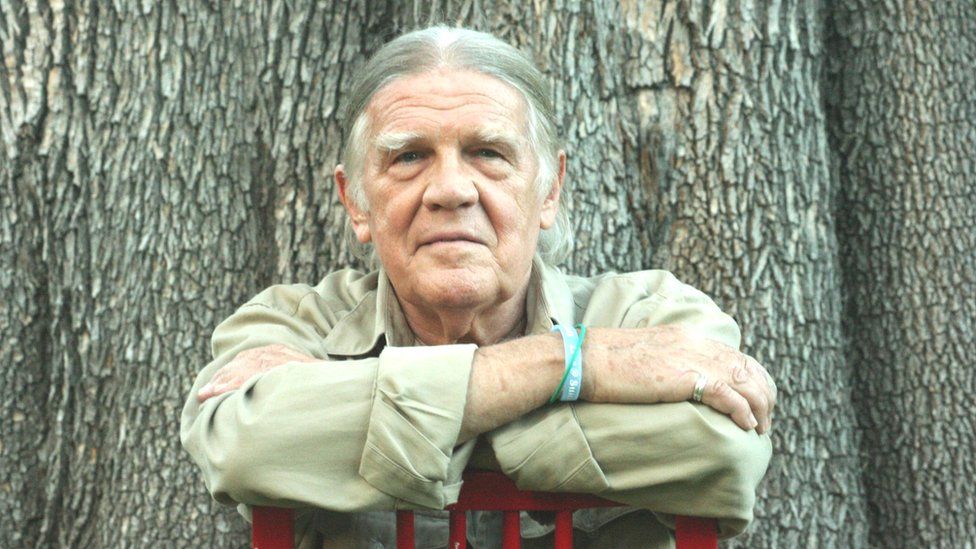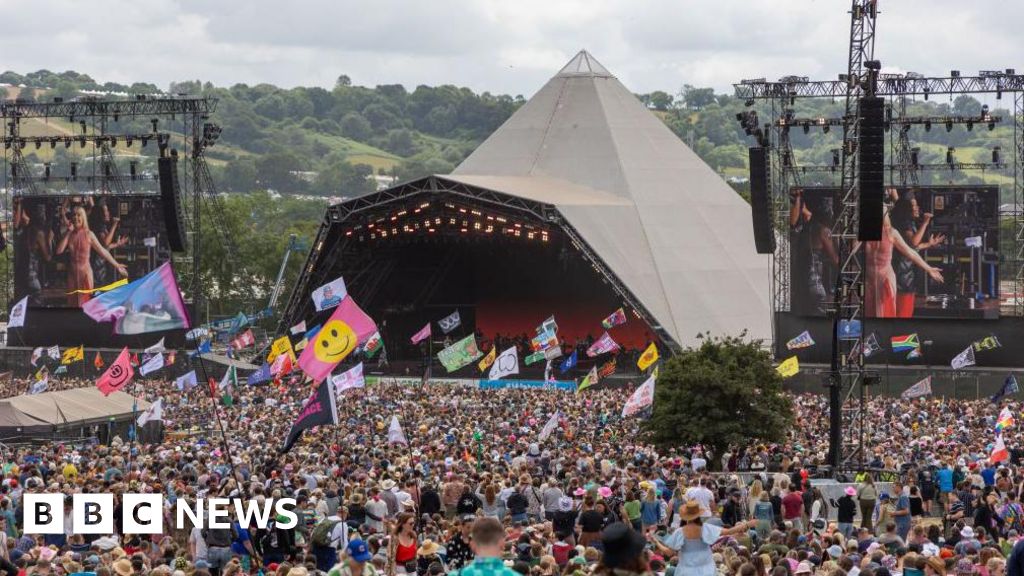ARTICLE AD BOX
 Image source, Henry Diltz / Paul Zollo
Image source, Henry Diltz / Paul Zollo
Henry Diltz has photographed everyone from Paul McCartney to Kurt Cobain over a career that spans seven decades
By Mark Savage
BBC Music Correspondent
He's shot more than 250 album covers, was the official photographer at Woodstock, and saw his work appear in Life Magazine. But Henry Diltz considers his career a lucky accident.
"I never went to photo school, I've never had a job, I never even thought about it," he says.
"I just hung out with all my musician friends, taking photos. It's been a fun, adventurous lifestyle."
Despite that (or maybe because of it), he's responsible for some the most iconic images of the 1960s and 70s: David Crosby holding a gun made from the US flag to his head; Joni Mitchell playing lap steel guitar in the middle of a field; The Eagles, high on peyote, posing in the Joshua Tree National Park.
Image source, Henry Diltz
Image caption,David Crosby was in the middle of a phone call to Bob Dylan when Diltz grabbed this iconic image
As a musician himself, Diltz had unrivalled access to some of rock's biggest names - often contributing backing vocals and banjo parts to their albums when he wasn't behind the lens.
His ease around people like Neil Young, Debbie Harry and Jimi Hendrix meant he often caught them in private moments, lost in thought, or playing with their pets - and there's an organic, unposed aesthetic to his work that's impossible to recreate.
This Wednesday, the 84-year-old will receive the Icon prize at the Abbey Road Music Photography Awards. Over Zoom from his home in Los Angeles, Diltz talked us through some of his favourite images.
The one that started it all: Buffalo Springfield, 1966
Image source, Henry Diltz
Image caption,Diltz sold his first photo for $100 - the equivalent of $840 in 2023
"In 1969, I was in a band called Modern Folk Quartet playing at the University of Michigan, when someone looked out of the tour bus window and said, 'Oh look, a second-hand store.'
"We pulled over, walked in and there, next to the door, was a table with little Japanese 35mm cameras. I thought, 'Yeah, what the heck', and for the next couple of weeks, as we drove back to LA, we kept taking pictures of the many little adventures that happened.
"When we got home, we said, 'Well, let's have a slideshow'. We got all our friends together and when I saw that first slide, 8ft wide, glowing in the dark, it was magic. That's when I really became a photographer.
"It became a thing. Once a month, we'd get together 20 or 30 hippie friends and have a big slideshow. I'd always try to prepare interesting pictures - an old truck or a flower or an animal. I loved tattoos.
"Then one day, I happen to bump into Stephen Stills and he said, 'Hey, Buffalo Springfield is going to this folk club by the beach for a soundcheck. You want to come?'
"And I thought 'Yes, I do', because I wanted to go photograph people on the beach. I didn't even go into the soundcheck!
"A half hour later, I walked back to the parking lot and saw a huge two-storey mural of a guy on a bicycle and, as I was framing it up, Buffalo Springfield walked out. I said, 'Hey, you guys, can you just stand there for a minute?, because I wanted to show the comparison, the perspective, of how tall this mural was.
"Then apparently they did an interview with a magazine and told them about the photo, and they called and offered me $100 for it. That was a big deal: $100 was like a week's salary, and I'd never made a nickel from taking a picture before that."
The first album cover: Crosby, Stills and Nash, 1969
Image source, Henry Diltz
"I met Stephen Stills in 63. He was a young guy playing solo guitar in a coffee house and he liked my band because we had four-part harmonies.
"Six years later, he's left Buffalo Springfield, [David] Crosby has been kicked out of The Byrds, and they were singing together at parties. Mama Cass saw them and realised they needed a higher voice, and she also knew that Graham [Nash] wasn't happy in The Hollies. So she introduced everyone and kind of orchestrated [the band].
"As they were recording the first album, I was down at the studio. They didn't have a group shot, so we jumped in an old Ford 1950s station wagon that belonged to my friend Gary Burton, and drove around LA.
"When we saw that old house with the couch outside, they jumped out, sat down, and it framed up real nicely.
"But between the time I took the photo and getting it processed, they'd decided on the name Crosby, Stills and Nash. They said, 'That would make a great cover but, look, we're sitting in the wrong order: Nash, Stills, Crosby'.
"I said, 'That's not a problem. Let's go back. sit in the right order, bang, bang, bang - five minutes. But when we got there, the house was gone. It had been bulldozed and turned into a parking lot.
"So we had to keep the first one."
A portrait of Paul and Linda McCartney: Life magazine, 1971
Image source, Henry Diltz
"I met Linda Eastman in a New York photo lab, getting some films developed, and we got to be friendly over lunch. Then one day, I read that she'd married Paul McCartney. I was like, 'Wow, go figure!'
"A year later, I got a call from her and she said, 'Henry, we're out in Malibu, and we need some pictures for the RAM album'. So I went out and spent the afternoon sitting around the swimming pool, eating lunch, with the little girls Heather and Mary.
"As I was taking pictures, Paul was sitting in a deck chair, plucking on his ukulele. I saw Heather and Mary hold hands and jump into the pool together. Without stopping, Paul started singing, 'Two little sisters jumping in the pool'. It was a beautiful little melody and I thought, oh my God, there's a Beatles song that only I will ever hear.
"Towards the end of the day, Linda told me, 'We need a nice portrait of the two of us', so we went over, brought some flowers and took the pictures. Then she said, 'We need these first thing in the morning because we want to send one to Life magazine'.
"Life magazine was the Holy Grail for photographers, so of course I got there early. This was 1971, before scanning and emailing, so the lady from Life magazine was there, in the living room. She looked through the pictures on a slide board, picked one, put it in her purse, went to the airport and flew to New York with it. And that was the cover."
Keith Richards living his best life, 1979
Image source, Henry Diltz
"I never went on the road with the Rolling Stones but I did go on the road with the New Barbarians, which was Ronnie Wood's solo group, with Keith on guitar.
"It was like the Stones without Mick [Jagger]. The boss wasn't there, so everything is allowed. It was wonderful. Every day, we'd fly into another city on one of those big passenger jets with couches and a bar and stuff like that.
"When they landed, eight limos would drive up and surround the aeroplane to take them to the hotel. On this day, Keith came out first and he leant on one of the cars while he was waiting for Ronnie to come out, with a bottle of Jack Daniels still in his hands.
"I went 'click' and that was that. It's not a pose. I didn't want to change reality. I never said to anyone, 'Stop doing what you're doing, stand over here and smile'. I wanted to see these guys doing what they did in real life."
The guerilla photoshoot: The Doors, 1970
Image source, Henry Diltz
"The Doors had seen the Crosby, Stills and Nash album and loved it, so I went over to their office.
"Jim [Morrison] and Ray Manzarek were there. and I said, 'OK, have you got a title?'
"'No, we don't have a title'.
"'Do you have an idea for your album cover?'
"'No. We thought you might.'
"Then Ray said, 'My wife Dorothy and I were driving through downtown LA the other day and we saw this building that said Morrison Hotel on the window.'
"So we got in a Volkswagen van and drove there. It was a funky old place where winos could sleep it off, you know? But the young guy behind the desk said, 'No, no, you can't take any pictures. You have to have the owner's permission'.
"He was a fairly famous slumlord and they were afraid of him. So we reluctantly stood outside and took some pictures, when suddenly I saw a light go off in the lobby. I peered in the window, and the guy had left the desk.
"I said to the band, 'Quick! Run in there!' And they did. There was none of that, 'You need to move to the left, you guys should trade places'. They just got behind the window. I took one roll of film and got out of there before they could stop us!"
The Abbey Road Photography Awards take place on Thursday, 21 September.

 1 year ago
30
1 year ago
30








 English (US) ·
English (US) ·